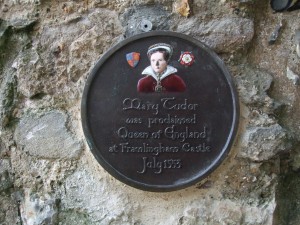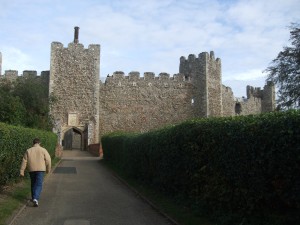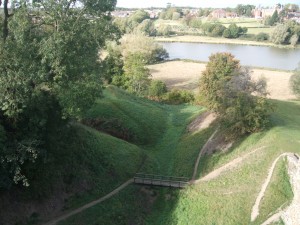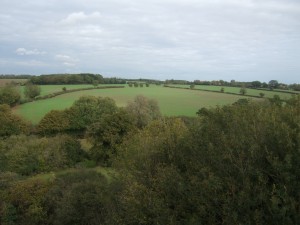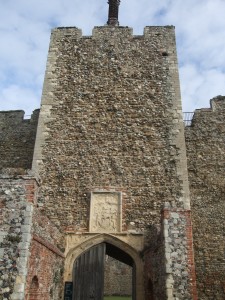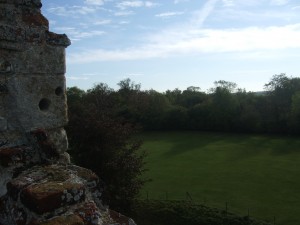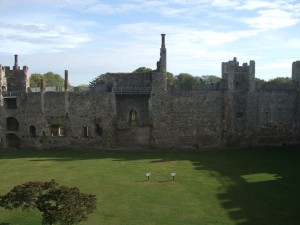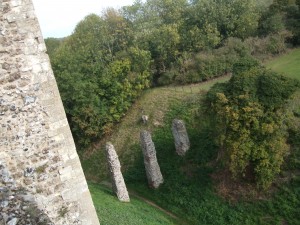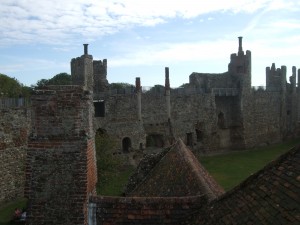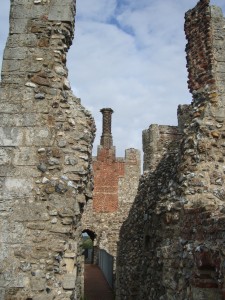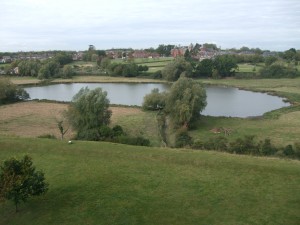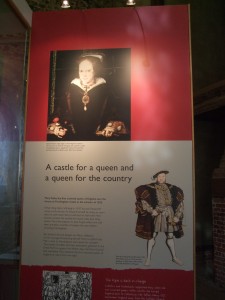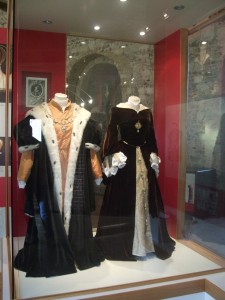‘In the 16th century, the castle was the scene of a national drama, when it was briefly owned by Mary Tudor, daughter of Henry VIII. Pursued by the followers of Lady Jane Grey in 1553, Mary fled to Framlingham and gathered her troops. She was still at the castle when she received news that she had been proclaimed England’s first ruling queen.’ (1)
‘The present-day external appearance of Framlingham Castle is virtually unchanged from how the castle would have looked to Mary Tudor…Now, as then, Framingham is a handsome fortress, built on top of a gentle green mound, overlooking the lake and wetlands of the adjacent mere.’ (2)
‘The castle is formed of thirteen mighty towers, each consecutively connected by an 8.2-foot-thick curtain wall, forming a loop shaped like a signet ring. The towers and the tops of the curtain walls have a distinct sawtoothed pattern of crenellation and are studded with arrow-loops for archers – marking out Framlingham Castle as a place of military might.’ (3)
‘Beyond the castle walls, stretching to the north and west, was the castle’s great park. It was in existence by at least 1286, and it was maintained until the area was broken up into fields after 1589. It was primarily a deer park…Various royal visitors hunted in Framllingham’s great park, including ‘the French queen’ (Mary, sister of Henry VIII and widow of Louis XII of France), in 1517.’ (4)
‘Built by the Bigod family in the 12th century, the castle was home to the earls and dukes of Norfolk for over 400 years. In the 14th century it passed to the Brotherton family, cousins of the king, then to the Mowbrays, created dukes of Norfolk in 1397. The Howard family inherited it in 1483, and spent lavishly on refurbishing it.’ (5)
‘Through the disgrace of Thomas Howard, third duke of Norfolk, Framlingham came into the hands of Mary Tudor, eldest daughter of Henry VIII and his first wife, Catherine of Aragon. Mary had been granted most of the Howard estates in East Anglia in her father’s will of 1547 and received Framlingham in 1552.’ (6)
1553 Succession Crisis
‘Although Henry’s will named Princess Mary as Edward’s heir, the young king had tried to surrender the Tudor line in favour of the Protestant Lady Jane Grey. On Edward’s death on 6 July 1553, the Duke of Northumberland moved to secure the succession for his daughter-in-law. As legal heir, Mary knew her position was dangerous, and on receiving warning of Northumberland’s plans to capture her, she fled secretly to Cambridgeshire and then to Kenninghall in Norfolk. From there she moved to Framlingham, the most secure of her properties, arriving in the evening of 12 July.’ (7)
Anna Whitelock writes that Mary’s ‘standard was unravelled and displayed over the gate tower.’ (8)
‘On the 20th, Mary rode down from the castle to review her troops. Standards were unfurled and her forces drawn up in battle order; helmets were thrown high in the air as shouts of ‘Long live our Good Queen Mary!’ and ‘Death to the traitors!’ rang out across Suffolk. Mary dismounted and for the next three hours inspected her troops on foot.’ (9)
‘Nowadays, although the mighty outer curtain wall remains intact, barely any buildings remain standing inside it. All we can see is a smattering of windows and fireplaces studded along the eastern aspect of the curtain wall, which without the rooms that once surrounded them, almost appear to float in mid-air.’ (10)
Sources
1.Stacey, N. (2011) Framlingham Castle (English Heritage Guidebooks), English Heritage, p.3.
2.Morris, E. (2015) Exploring English Castles: Evocative, Romantic, and Mysterious True Tales of the Kings and Queens of the British Isles, Sky Pony Press, p.216.
3.Ibid.
4.Stacey, N. (2011) Framlingham Castle (English Heritage Guidebooks), English Heritage, p.15.
5.Ibid, p.5.
6.Ibid, p.34.
7.Ibid.
8.Whitelock, A. (2009) Mary Tudor: England’s First Queen, Bloomsbury Publishing, p.170-1.
9.Ibid, p.173.
10.Morris, E. (2015) Exploring English Castles: Evocative, Romantic, and Mysterious True Tales of the Kings and Queens of the British Isles, Sky Pony Press, p.231.
11.Stacey, N. (2011) Framlingham Castle (English Heritage Guidebooks), English Heritage, p.19.

